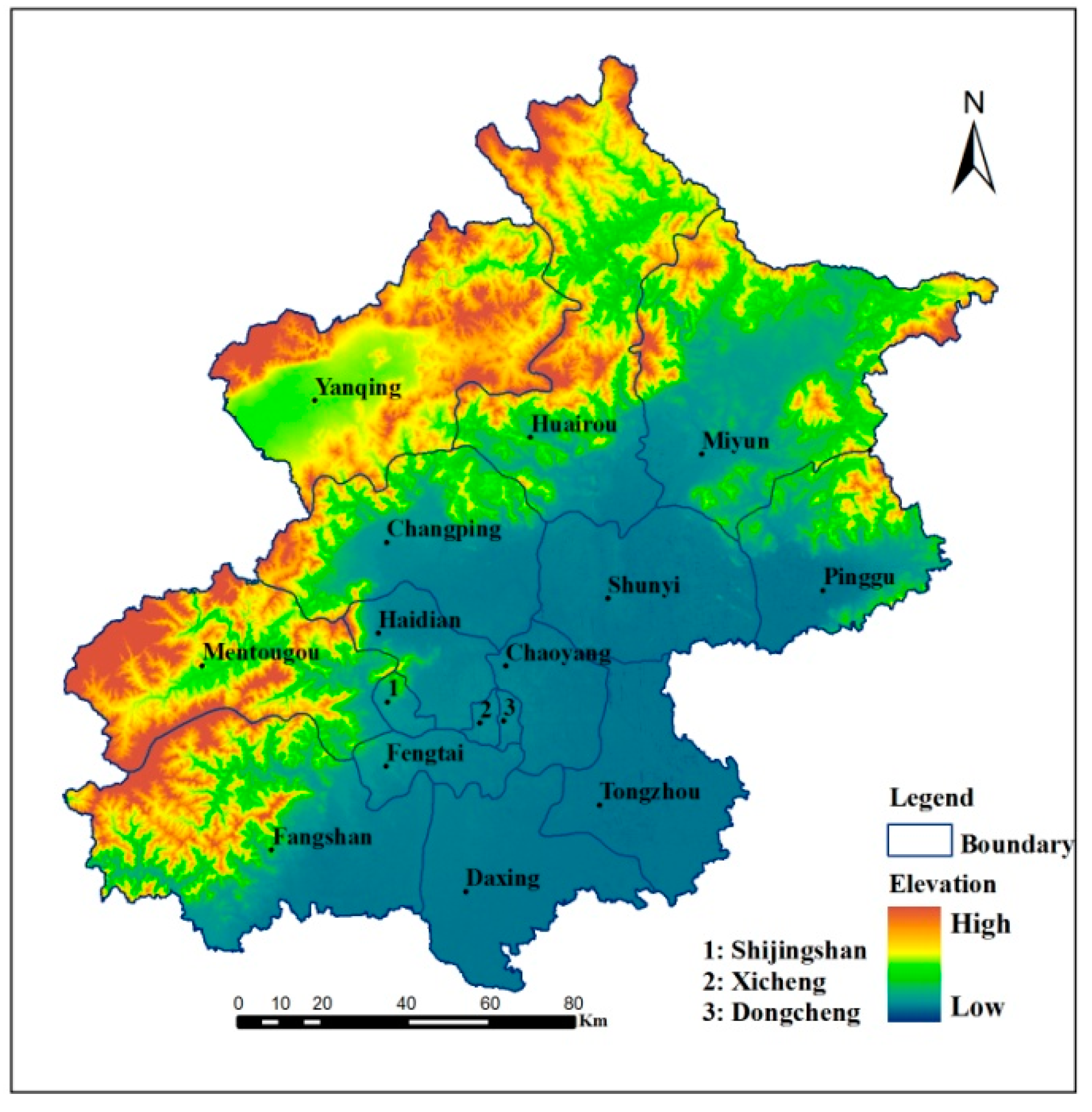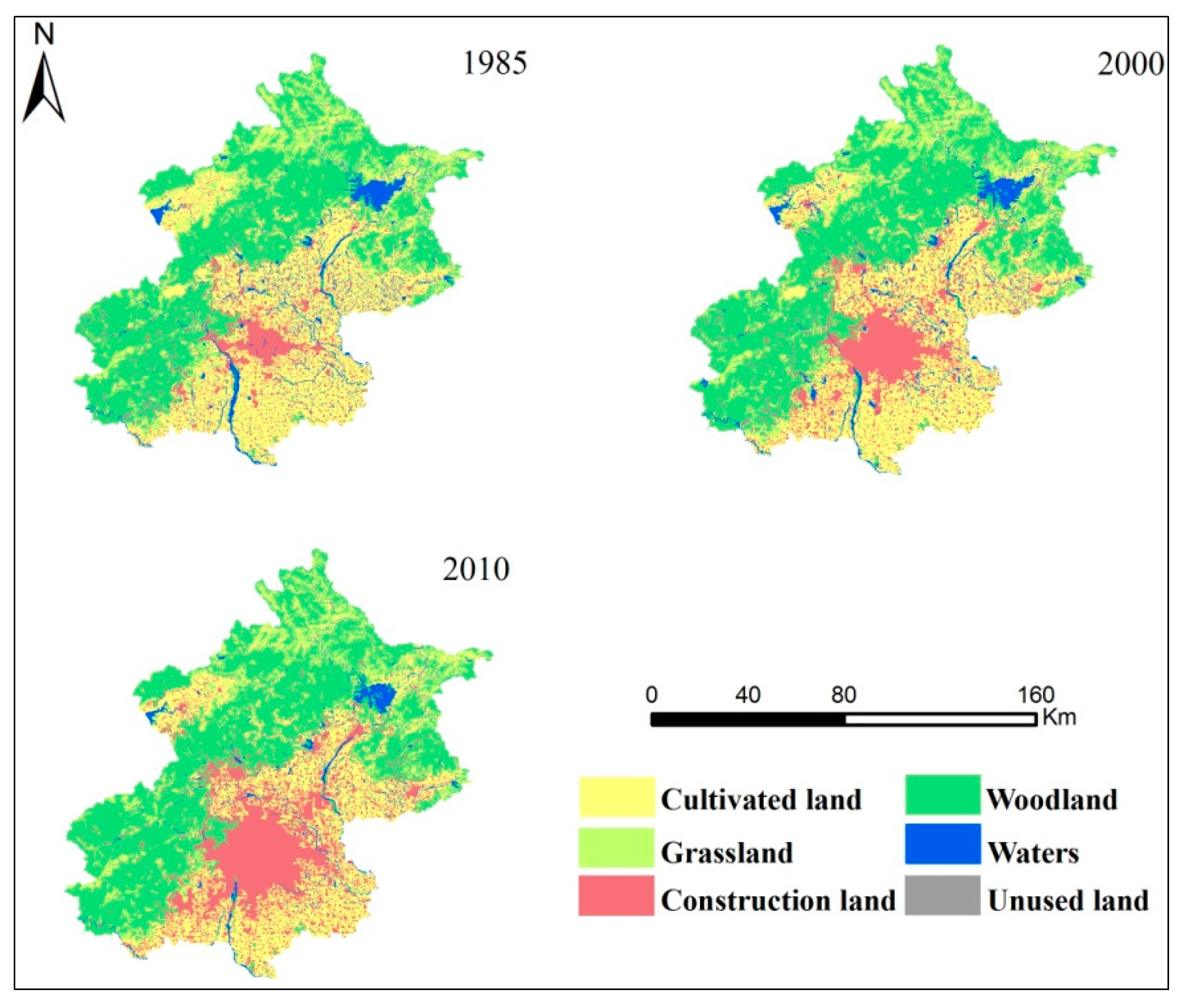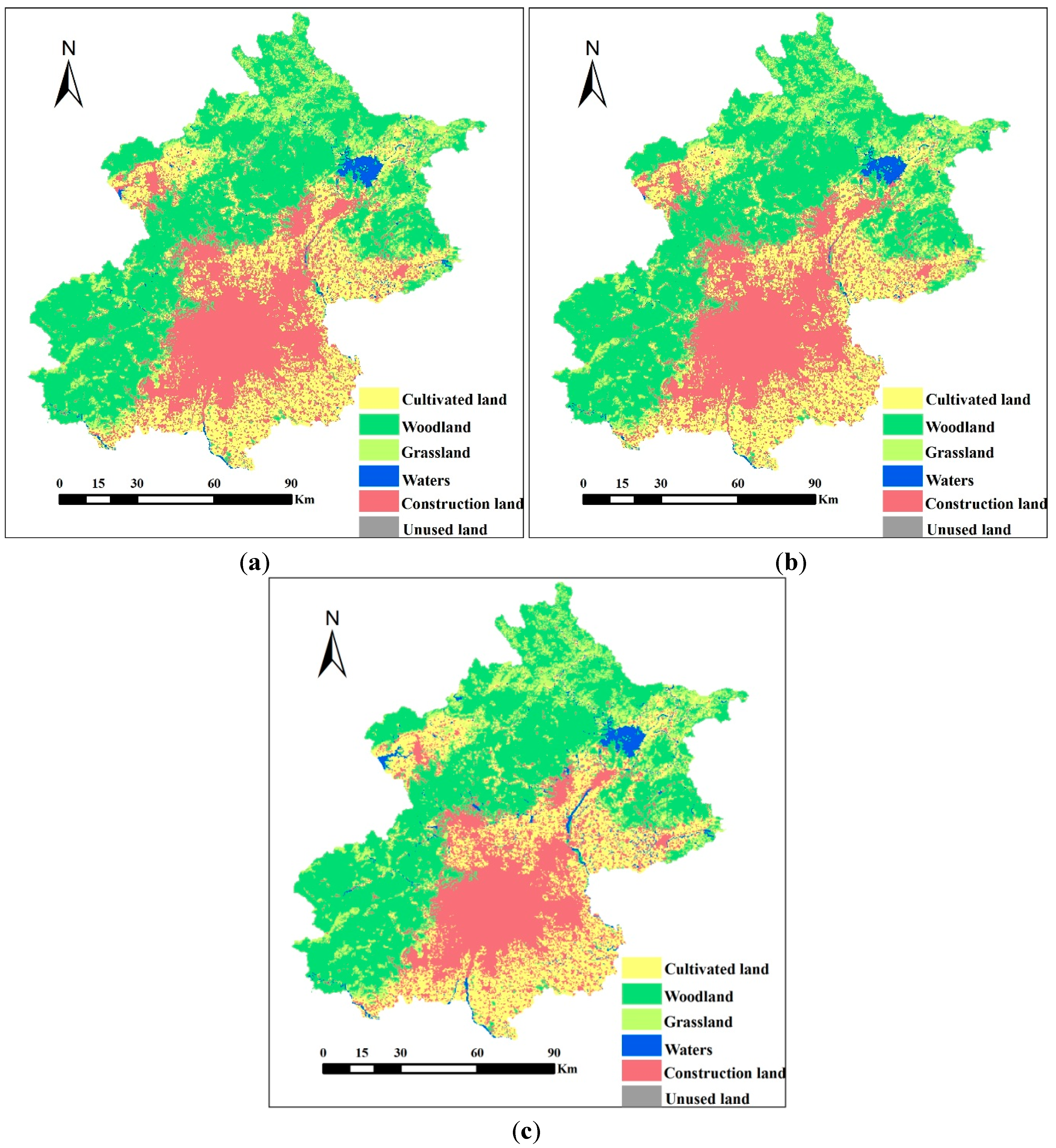Scenario Simulation and the Prediction of Land Use and Land Cover Change in Beijing, China
Abstract
:1. Introduction
2. Materials and Methods
2.1. Study Area

2.2. Data
2.3. Methods
2.3.1. Land Use Dynamic Degree
2.3.2. Markov Model
2.3.3. CLUE-S Model
3. Results and Analysis
3.1. LULC Change Characteristics

3.2. Regression Analysis of the LULC Change Process
| Driving factors | Years | Cultivated land | Woodland | Grassland | Waters | Construction land | Unused land | ||||||
|---|---|---|---|---|---|---|---|---|---|---|---|---|---|
| β | Exp(β) | β | Exp(β) | β | Exp(β) | β | Exp(β) | β | Exp(β) | β | Exp(β) | ||
| Elevation | 2000 | −0.0011 | 0.9989 | 0.0004 | 1.0004 | 0.0011 | 1.0011 | ||||||
| 2010 | −0.0008 | 0.9992 | −0.0003 | 0.9997 | 0.0015 | 1.0015 | |||||||
| Slope | 2000 | −0.2270 | 0.7734 | 0.0331 | 1.0337 | −0.0264 | 0.9739 | −0.0220 | 0.9783 | −0.0581 | 0.9435 | ||
| 2010 | −0.1121 | 0.8980 | 0.0171 | 1.0173 | −0.0217 | 0.9785 | |||||||
| Distance to the river | 2000 | −0.0614 | 0.9404 | 0.0917 | 1.0960 | −0.0476 | 0.9535 | −0.1784 | 0.8366 | 0.0620 | 1.0640 | ||
| 2010 | −0.0606 | 0.9412 | 0.0954 | 1.1001 | −0.0430 | 0.9579 | −0.2470 | 0.7812 | 0.0260 | 1.0263 | |||
| Distance to the urban center | 2000 | 0.0234 | 1.0669 | 0.0185 | 1.0187 | 0.0519 | 1.0533 | −0.0838 | 0.9196 | 0.0609 | 1.0628 | ||
| 2010 | 0.0088 | 1.0212 | 0.0155 | 1.0156 | 0.0633 | 1.0654 | −0.0877 | 0.9160 | −0.0859 | 0.9177 | |||
| Distance to the local road | 2000 | 0.0351 | 1.0358 | −0.1481 | 0.8623 | ||||||||
| 2010 | 0.0505 | 1.0518 | 0.0296 | 1.0301 | 0.0464 | 1.0475 | −0.1658 | 0.8472 | |||||
| Distance to the railway | 2000 | 0.0504 | 1.0517 | −0.0630 | 0.9389 | −0.0410 | 0.9598 | 0.0367 | 1.0640 | −0.0423 | 0.9585 | ||
| 2010 | 0.0331 | 1.0336 | −0.0491 | 0.9521 | −0.0215 | 0.9787 | 0.0513 | 1.0603 | |||||
| Distance to the highway | 2000 | 0.0432 | 1.0577 | 0.0606 | 1.0625 | 0.0204 | 1.0206 | −0.0546 | 0.9468 | ||||
| 2010 | 0.0357 | 1.0349 | 0.0628 | 1.0648 | −0.0657 | 0.9364 | |||||||
| GDP | 2000 | −0.0225 | 0.9777 | −0.0185 | 0.9815 | 0.0322 | 1.0327 | ||||||
| 2010 | 0.0015 | 1.0015 | 0.0015 | 1.0015 | 0.0013 | 1.0013 | |||||||
| Urbanization | 2000 | −0.0274 | 0.9726 | −0.0985 | 0.9062 | −0.0807 | 0.9225 | −0.0173 | 0.9828 | 0.0362 | 1.0369 | ||
| 2010 | −0.0055 | 0.9943 | −0.0146 | 0.9855 | −0.0347 | 0.9659 | |||||||
| Population density | 2000 | 0.0006 | 1.0006 | 0.0002 | 1.0002 | −0.0002 | 0.9998 | ||||||
| 2010 | −0.0404 | 0.9584 | −0.0011 | 0.9989 | −0.0005 | 0.9995 | −0.0014 | 0.9986 | 0.0013 | 1.0013 | |||
| Constant | 2000 | −0.3677 | 0.6923 | 0.9723 | 2.6440 | −1.7567 | 0.1726 | −3.3856 | 0.0339 | −1.3041 | 0.2714 | −6.5598 | 0.0014 |
| 2010 | −0.0352 | 0.9654 | −0.8484 | 0.4281 | −3.1322 | 0.0436 | −4.3192 | 0.0133 | 0.2457 | 1.2785 | −4.8677 | 0.0077 | |
| ROC value | 2000 | 0.7730 | 0.8460 | 0.8100 | 0.7470 | 0.8250 | 0.7990 | ||||||
| 2010 | 0.7080 | 0.8300 | 0.7970 | 0.7980 | 0.8390 | 0.7320 | |||||||
3.3. Analysis of Transition Probability Matrix
| Cultivated land | Woodland | Grassland | Waters | Construction land | Unused land | |
|---|---|---|---|---|---|---|
| Cultivated land | 0.83 | 0.02 | 0.00 | 0.02 | 0.13 | 0.00 |
| Woodland | 0.00 | 0.99 | 0.00 | 0.01 | 0.00 | 0.00 |
| Grassland | 0.01 | 0.03 | 0.94 | 0.02 | 0.00 | 0.00 |
| Waters | 0.21 | 0.06 | 0.01 | 0.63 | 0.09 | 0.00 |
| Construction land | 0.00 | 0.00 | 0.00 | 0.01 | 0.99 | 0.00 |
| Unused land | 0.25 | 0.02 | 0.01 | 0.02 | 0.08 | 0.62 |
| Cultivated land | Woodland | Grassland | Waters | Construction land | Unused land | |
|---|---|---|---|---|---|---|
| Cultivated land | 0.78 | 0.03 | 0.00 | 0.01 | 0.17 | 0.01 |
| Woodland | 0.01 | 0.97 | 0.00 | 0.01 | 0.01 | 0.00 |
| Grassland | 0.02 | 0.04 | 0.92 | 0.00 | 0.02 | 0.00 |
| Waters | 0.17 | 0.05 | 0.04 | 0.58 | 0.15 | 0.01 |
| Construction land | 0.04 | 0.01 | 0.00 | 0.00 | 0.94 | 0.01 |
| Unused land | 0.04 | 0.61 | 0.14 | 0.00 | 0.05 | 0.16 |
3.4. Predicting LULC Change Based on the Markov Model
| Years | Scenario design | Cultivated land | Woodland | Grassland | Waters | Construction land | Unused land |
|---|---|---|---|---|---|---|---|
| 2010 | Actual land use | 406,692 | 741,789 | 119,772 | 44,082 | 311,013 | 10,305 |
| 2020 | Natural development | 333,279 | 756,891 | 115,083 | 21,330 | 400,014 | 7056 |
| Rapid development | 328,535 | 757,223 | 114,975 | 17,333 | 408,672 | 6916 | |
| Ecological-cultivated land protection | 360,912 | 751,635 | 116,718 | 34,890 | 364,575 | 4923 |
3.5. Model Validation

3.6. Analysis of Simulation Results

4. Discussion
5. Conclusions
Acknowledgments
Author Contributions
Conflicts of Interest
References
- Lambin, E.F.; Baulies, X.; Bockstael, N.; Fischer, G.; Krug, T.; Leemans, R.; Moran, E.F.; Rindfuss, R.R.; Skole, D.; Turner ll, B.L.; et al. Land-Use and Land-Cover Change: Implementation Strategy; IGBP Report No.48/IHDP Report No. 10; IGBP Secretariat: Stockholm, Sweden, 1999; pp. 125–126. [Google Scholar]
- Turner, B.L., II; Skole, D.L.; Sanderson, S.; Fischer, G.; Fresco, L.O.; Leemans, R. Land-Use and Land-Cover Change Science/Research Plan; IGBP Report No.35/HDP Report No.7; IGBP Secretariat: Stockholm, Sweden, 1995; pp. 132–133. [Google Scholar]
- Liu, J.Y.; Kuang, W.H.; Zhang, Z.X.; Xu, X.L.; Qin, Y.W.; Ning, J.; Zhou, W.C.; Zhang, S.W.; Li, R.D.; Yan, C.Z.; et al. Spatiotemporal characteristics, patterns, and causes of land-use changes in China since the late 1980s. Chin. Geogr. Sci. 2014, 24, 195–210. [Google Scholar] [CrossRef]
- Meyer, W.B.; Turner, B.L. Human population growth and global land-use/cover change. Annu. Rev. Ecol. Syst. 1992, 23, 39–61. [Google Scholar] [CrossRef]
- Dewan, A.M.; Yamaguchi, Y. Land use and land cover change in Greater Dhaka, Bangladesh: Using remote sensing to promote sustainable urbanization. Appl. Geogr. 2009, 29, 390–401. [Google Scholar] [CrossRef]
- Dewan, A.M.; Kabir, M.H.; Nahar, K.; Rahman, M.Z. Urbanization and environmental degradation in Dhaka metropolitan area of Bangladesh. Int. J. Environ. Sustain. Dev. 2012, 2, 118–147. [Google Scholar] [CrossRef]
- Byomkesh, T.; Nakagoshi, N.; Dewan, A.M. Urbanization and green space dynamics in Greater Dhaka, Bangladesh. Landsc. Ecol. Eng. 2012, 8, 45–58. [Google Scholar] [CrossRef]
- Corner, R.J.; Dewan, A.M.; Chakma, S. Monitoring and prediction of land-use and land-cover (LULC) change. In Proceedings of Dhaka Megacity—Geospatial Perspectives on Urbanization, Environment and Health: Chapter 5; Dewan, A.M., Corner, R.J., Eds.; Springer Geography: Berlin, Germany, 2014; pp. 75–97. [Google Scholar]
- Yin, Z.; Walcott, S.; Kaplan, B.; Cao, J.; Lin, W.; Chen, M.; Liu, D.; Ning, Y. An analysis of the relationship between spatial patterns of water quality and urban development in Shanghai China. Comput. Environ. Urban. 2005, 29, 197–221. [Google Scholar] [CrossRef]
- Zhao, S.; Da, L.; Tang, Z.; Fang, H.; Song, K.; Fang, J. Ecological consequences of rapid urban expansion: Shanghai, China. Front. Ecol. Environ. 2006, 4, 341–346. [Google Scholar] [CrossRef]
- Dewan, A.M.; Yamaguchi, Y. Effect of land cover changes on flooding: example from Greater Dhaka of Bangladesh. Int. J. Geoinf. 2008, 4, 11–20. [Google Scholar]
- Dewan, A.M.; Yamaguchi, Y.; Ziaur Rahman, M. Dynamics of land use/cover changes and the analysis of landscape fragmentation in Dhaka metropolitan, Bangladesh. Geojournal 2012, 77, 315–330. [Google Scholar] [CrossRef]
- Liu, W.D. Thinking of Economic Geography; Sciences Press: Beijing, China, 2013; pp. 164–165. [Google Scholar]
- Verburg, P.H.; Schot, P.P.; Dijst, M.J.; Veldkamp, A. Land use change modelling: Current practice and research priorities. Geojournal 2004, 61, 309–324. [Google Scholar] [CrossRef]
- Schaldach, R.; Alcamo, J.; Koch, J.; Kölking, C.; Lapola, D.M.; Schüngel, J.; Priess, J.A. An integrated approach to modeling land-use change on continental and global scales. Environ. Model. Softw. 2011, 26, 1041–1051. [Google Scholar] [CrossRef]
- Imbernon, J. Pattern and development of changes in the Kenyan highlands since the 1950s. Agr. Ecosyst. Environ. 1999, 176, 67–73. [Google Scholar] [CrossRef]
- Tian, Y.; Yin, K.; Lu, D.; Hua, L.; Zhao, Q.; Wen, M. Examining land use and land cover spatiotemporal change and driving forces in Beijing from 1978 to 2010. Remote Sens. 2014, 6, 10593–10611. [Google Scholar] [CrossRef]
- Kidron, G.J.; Karnieli, A.; Benenson, I.; Grinblat, Y. Simulating land-use degradation in West Africa with the ALADYN model. J. Arid. Environ. 2015, 112, 52–63. [Google Scholar] [CrossRef]
- Xu, Q.; Yang, K.; Wang, G.; Yang, Y. Agent-based modeling and simulations of land-use and land-cover change according to ant colony optimization: A case study of the Erhai Lake Basin, China. Nat. Hazards 2015, 75, 95–118. [Google Scholar] [CrossRef]
- Yi, Q.; Lam, N.S.N. Modeling land use and land cover changes in a vulnerable coastal region using artificial neural networks and cellular automata. Environ. Monit. Assess. 2015. [Google Scholar] [CrossRef]
- Badreldin, N.; Goossens, R. Monitoring land use/land cover change using multi-temporal Landsat satellite images in an arid environment: A case study of El-Arish, Egypt. Arab. J. Geosci. 2014, 7, 1671–1681. [Google Scholar] [CrossRef]
- Pei, B.; Pan, T. Land use system dynamic modeling: literature review and future research direction in China. Prog. Geogr. 2010, 29, 1060–1066. [Google Scholar]
- Arsanjani, J.J.; Helbich, M.; Kainz, W.; Boloorani, A.D. Integration of logistic regression, Markov chain and cellular automata models to simulate urban expansion. Int. J. Appl. Earth Obs. Geoinf. 2013, 21, 265–275. [Google Scholar] [CrossRef]
- Ahmed, B.; Ahmed, R. Modeling urban land cover growth dynamics using multi-temporal satellite images: A case study of Dhaka, Bangladesh. ISPRS. Int. J. Geoinf. 2012, 1, 3–31. [Google Scholar] [CrossRef]
- Vaz, E.; Walczynska, A.; Nijkamp, P. Regional challenges in tourist wetland systems: An integrated approach to the Ria Formosa in the Algarve, Portugal, 2013. Reg. Environ. Change 2013, 13, 33–42. [Google Scholar] [CrossRef]
- Parker, D.C.; Manson, S.M.; Janssen, M.A.; Hoffmann, M.J.; Deadman, P. Multi-agent systems for the simulation of land-use and land-cover change: A review. Ann. Assoc. Am. Geogr. 2003, 93, 314–337. [Google Scholar] [CrossRef]
- Veldkamp, A.; Verbug, P.H.; Kok, K.; de Koning, G.H.J.; Priess, J.; Bergsma, A.R. The need for scale sensitive approaches in spatially explicit land use change modeling. Environ. Model. Assess. 2001, 6, 111–121. [Google Scholar] [CrossRef]
- Al-shalabi, M.; Billa, L.; Pradhan, B.; Mansor, S.; Al-Sharif, A.A. Modelling urban growth evolution and land-use changes using GIS based cellular automata and SLEUTH models: The case of Sana’a metropolitan city, Yemen. Environ. Earth. Sci. 2013, 70, 425–437. [Google Scholar] [CrossRef]
- Verburg, P.H.; Eickhout, B.; Meijl, H.V. A multi-scale, multi-model approach for analyzing the future dynamics of European land use. Ann. Regional. Sci. 2008, 42, 57–77. [Google Scholar] [CrossRef]
- Hubacek, K.; Sun, L. A scenario analysis of China’s land use and land cover change: Incorporating biophysical information into input–output modeling. Struct. Econ. Dynam. 2001, 12, 367–397. [Google Scholar] [CrossRef]
- Verburg, P.H.; Soepboer, W.; Veldkamp, A.; Limpiada, R.; Espaldon, V.; Mastura, S.S. Modeling the spatial dynamics of regional land use: The CLUE-S model. Environ. Manag. 2002, 30, 391–405. [Google Scholar] [CrossRef]
- Wu, J.S.; Feng, Z.; Gao, Y.; Huang, X.; Liu, H.; Huang, L. Recent progresses on the application and improvement of the CLUE-S model. Prog. Geogr. 2012, 31, 3–10. [Google Scholar]
- Wu, Q.; Li, H.Q.; Wang, R.S.; Paulussen, J.; He, Y.; Wang, M.; Wang, Z. Monitoring and predicting land use change in Beijing using remote sensing and GIS. Landsc. Urban Plan. 2006, 78, 322–333. [Google Scholar] [CrossRef]
- Lu, R.C.; Huang, X.J.; Zuo, T.H.; Xiao, S.S.; Zhao, X.F.; Zhang, X.Y. Land Use Scenarios Simulation Based on CLUE-S and Markov Composite Model—A Case Study of Taihu Lake Rim in Jiangsu Province. Sci. Geol. Sinica 2009, 29, 577–581. [Google Scholar]
- Nourqolipour, R.; Shariff, A.R.B.M.; Balasundram, S.K.; Ahmad, N.B.; Sood, A.M.; Buyong, T.; Amiri, F. A GIS-based model to analyze the spatial and temporal development of oil palm land use in Kuala Langat district, Malaysia. Environ. Earth Sci. 2015, 73, 1687–1700. [Google Scholar] [CrossRef]
- Wang, X.L.; Bao, Y.H. Study on the methods of land use dynamic change research. Prog. Geogr. 1999, 18, 81–87. [Google Scholar]
- Hu, Y.; Zheng, Y.; Zheng, X. Simulation of land-use scenarios for Beijing using CLUE-S and Markov composite models. Chin. Geogr. Sci. 2013, 23, 92–100. [Google Scholar] [CrossRef]
- Pontius, R.G., Jr.; Schneider, L.C. Land-cover change model validation by an ROC method for the Ipswich watershed, Massachusetts, USA. Agr. Ecosyst. Environ. 2001, 85, 239–248. [Google Scholar] [CrossRef]
- Pontius, R.G., Jr; Cornell, J.D.; Hall, C.A. Modeling the spatial pattern of land-use change with GEOMOD2: Application and validation for Costa Rica. Agr. Ecosyst. Environ. 2001, 85, 191–203. [Google Scholar] [CrossRef]
- Pontius, R.G., Jr.; Malanson, J. Comparison of the structure and accuracy of two land change models. Int. J. Geogr. Inf. Sci. 2005, 19, 243–265. [Google Scholar] [CrossRef]
- Kamusoko, C.; Aniya, M.; Adi, B.; Manjoro, M. Rural sustainability under threat in Zimbabwe—Simulation of future land use/cover changes in the Bindura district based on the Markov-cellular automata model. Appl. Geogr. 2009, 29, 435–447. [Google Scholar] [CrossRef]
- Verburg, P.H.; Overmars, K.P. Dynamic simulation of land-use change trajectories with the CLUE-s model. Model. Land-Use Change 2007, 90, 321–337. [Google Scholar]
- Wan, L.; Jin, Y. Review on applied urban modeling and new trends of urban spatial policy models. Urban Plan. Forum. 2014, 1, 81–91. [Google Scholar]
- Barra, D.L.T. Integrated Land Use and Transport Modeling. Decision Chains and Hierarchies; Cambridge University Press: Cambridge, UK, 1989. [Google Scholar]
- Liu, L.; Long, Y.; Batty, M. A retrospect and prospect of urban models: Reflections after interviewing Mike Batty. City Plan. Rev. 2014, 38, 63–70. [Google Scholar]
- Wegener, M. The IRPUD model. Spiekermann & Wegener in Dortmund. Available online: http://www.spiekermann-wegener.com/mod/pdf/AP_1101_IRPUD_Model.pdf (accessed on 1 December 2011).
- Simmonds, D.C. The design of the delta land-use modeling package. Gen. Inf. 1999, 26, 665–684. [Google Scholar]
- Waddell, P. Urbansim: Modeling urban development for land use, transportation, and environmental planning. J. Am. Plann. Assoc. 2002, 68, 297–314. [Google Scholar] [CrossRef]
- Zondag, B.; De Bok, M.; Geurs, K.T.; Molenwijk, E. Accessibility modeling and evaluation: The TIGRIS XL land-use and transport interaction model for the Netherlands. Comput. Environ. Urban 2015, 49, 115–125. [Google Scholar] [CrossRef]
- Pontius, R.G., Jr.; Huffaker, D.; Denman, K. Useful techniques of validation for spatially explicit land-change models. Ecol. Model. 2004, 179, 445–461. [Google Scholar] [CrossRef]
- Brueckner, J.K.; Kim, H. Urban sprawl and the property tax. Int. Tax Public Finan. 2003, 10, 5–23. [Google Scholar] [CrossRef]
- Tsai, Y. Housing demand forces and land use towards urban compactness: A push-accessibility-pull analysis framework. Urban Stud. 2014, 6, 1–17. [Google Scholar]
- Castella, J.C.; Pheng Kam, S.; Dinh Quang, D.; Verburg, P.H.; Thai Hoanh, C. Combining top-down and bottom-up modelling approaches of land use/cover change to support public policies: Application to sustainable management of natural resources in northern Vietnam. Land. Use. Policy 2007, 24, 531–545. [Google Scholar] [CrossRef]
- De Bok, M.; Zondag, B.; Petersen, E. Modeling land use in the Generic Urban Model. In Proceedings of European Transport Conference (ETC), Strasbourg, France, 18–20 September 2006; pp. 15–28.
- Yigitcanlar, T.; Dur, F. Developing a sustainability assessment model: The sustainable infrastructure, land-use, environment and transport model. Sustainability 2010, 1, 321–340. [Google Scholar] [CrossRef]
© 2015 by the authors; licensee MDPI, Basel, Switzerland. This article is an open access article distributed under the terms and conditions of the Creative Commons Attribution license (http://creativecommons.org/licenses/by/4.0/).
Share and Cite
Han, H.; Yang, C.; Song, J. Scenario Simulation and the Prediction of Land Use and Land Cover Change in Beijing, China. Sustainability 2015, 7, 4260-4279. https://doi.org/10.3390/su7044260
Han H, Yang C, Song J. Scenario Simulation and the Prediction of Land Use and Land Cover Change in Beijing, China. Sustainability. 2015; 7(4):4260-4279. https://doi.org/10.3390/su7044260
Chicago/Turabian StyleHan, Huiran, Chengfeng Yang, and Jinping Song. 2015. "Scenario Simulation and the Prediction of Land Use and Land Cover Change in Beijing, China" Sustainability 7, no. 4: 4260-4279. https://doi.org/10.3390/su7044260
APA StyleHan, H., Yang, C., & Song, J. (2015). Scenario Simulation and the Prediction of Land Use and Land Cover Change in Beijing, China. Sustainability, 7(4), 4260-4279. https://doi.org/10.3390/su7044260





